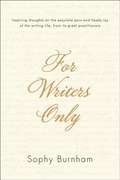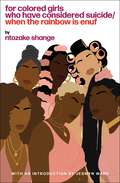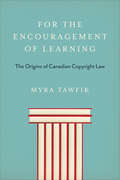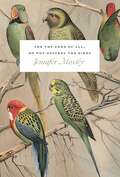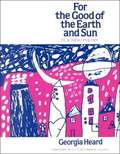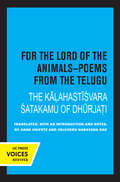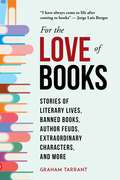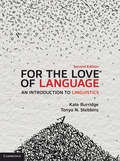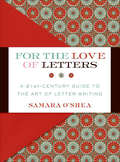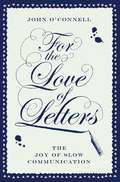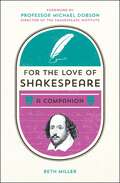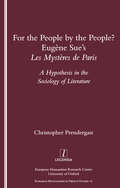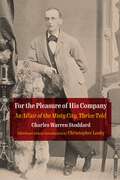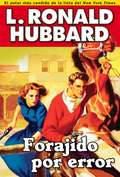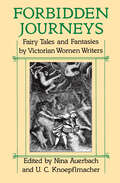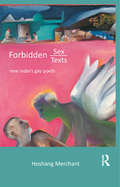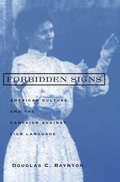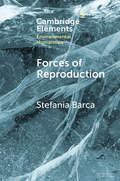- Table View
- List View
For Writers Only
by Sophy Burnham"I see but one rule: to be clear. " --Stendhal If only it were as easy for most writers as it was for Stendhal. The truth about the act of writing is much more varied, even violent. In fact, there seem to be as many contradictory admonitions about how to go about doing it as there are writers themselves. With that in mind, writer Sophy Burnham has collected the thoughts of some of the greatest writers and laced them with her own observations and experiences of the writer's life. With an emphasis on the emotions that writing wrings from those who practice it, Burnham writes about beginning a work prematurely, the ecstasy when the writing is really flowing, the crash that can follow the flight and how to pick yourself up and continue. Here you will find the motto Zola kept in his workroom (No day without lines), where Agatha Christie plotted her books (in the bathtub eating apples), and what James Thurber's wife replied when a dinner guest observed a strange expression on her husband's face (Don't be concerned. He's only writing). Most of all, you will be reassured, enlightened, and inspired to learn that, in your own writing struggles, you are not alone.
For colored girls who have considered suicide/When the rainbow is enuf
by Ntozake ShangeNtozake Shange&’s classic, award-winning play encompassing the wide-ranging experiences of Black women, now with introductions by two-time National Book Award winner Jesmyn Ward and Broadway director Camille A. Brown.From its inception in California in 1974 to its Broadway revival in 2022, the Obie Award–winning for colored girls who have considered suicide/when the rainbow is enuf has excited, inspired, and transformed audiences all over the country for nearly fifty years. Passionate and fearless, Shange&’s words reveal what it meant to be a woman of color in the 20th century. First published in 1975, when it was praised by The New Yorker for &“encompassing…every feeling and experience a woman has ever had,&” for colored girls who have considered suicide/when the rainbow is enuf will be read and performed for generations to come. Now with new introductions by Jesmyn Ward and Broadway director Camille A. Brown, and one poem not included in the original, here is the complete text of a groundbreaking dramatic prose poem that resonates with unusual beauty in its fierce message to the world.
For the Encouragement of Learning: The Origins of Canadian Copyright Law (Studies in Book and Print Culture)
by Myra TawfikFor the Encouragement of Learning addresses the contested history of copyright law in Canada, where the economic and reputational interests of authors and the commercial interests of publishers often conflict with the public interest in access to knowledge. It chronicles Canada’s earliest copyright law to explain how pre-Confederation policy-makers understood copyright’s normative purpose. Using government and private archives and copyright registration records, Myra Tawfik demonstrates that the nineteenth-century originators of copyright law intended to promote the advancement of learning in schools by encouraging the mass production of educational material. The book reveals that copyright laws were integral features of British North American education policy and highlights the important roles played by teachers, education reformers, and politicians in the emergence and development of the laws. It also explains how policy-makers began to consider the relationship between copyright and cultural identity formation once British interference into domestic copyright affairs increased, and as Canadian Confederation neared. Using methodologies at the intersection of legal history and book history, For the Encouragement of Learning embeds the copyright legal framework within the history of Canada’s book and print culture.
For the Good of All, Do Not Destroy the Birds: Essays
by Jennifer MoxleyIn this collection of essays, the author draws upon a wide range of sources, from Greek mythology and modern poetry to her personal experiences with pigeons and parakeets. Birds and their symbolism in art and literature are featured in each essay.
For the Good of the Earth and Sun: Teaching Poetry
by Georgia Heard Lucy Mccormick-CalkinsThe principles of teaching poetry discussed are applicable to any classroom of student poets, regardless of age.
For the Lord of the Animals-Poems from The Telugu: The Kalahastisvara Satakamu of Dhurjati
by Velcheru Narayana Rao Hank HeifetzThis title is part of UC Press's Voices Revived program, which commemorates University of California Press’s mission to seek out and cultivate the brightest minds and give them voice, reach, and impact. Drawing on a backlist dating to 1893, Voices Revived makes high-quality, peer-reviewed scholarship accessible once again using print-on-demand technology. This title was originally published in 1987.
For the Love of Books: A Celebration of the Written Word
by Graham TarrantFrom banned books to feuding authors, from literary felons to rejected masterpieces, from tips for aspiring writers to stand-out book lists, this treasure trove of compelling facts, riveting anecdotes and extraordinary characters is every book-lover’s dream: a book about books and the people who write them. Read all about it!
For the Love of Books: Stories of Literary Lives, Banned Books, Author Feuds, Extraordinary Characters, and More
by Graham TarrantA light-hearted book about books and the people who write them for all lovers of literature. Do you know: Which famous author died of caffeine poisoning?Why Alice’s Adventures in Wonderland was banned in China?Who was the first British writer to win the Nobel Prize in Literature?What superstitions Truman Capote kept whenever he wrote?Who the other Winston Churchill was? A treasure trove of compelling facts, riveting anecdotes, and extraordinary characters, For the Love of Books is a book about books—and the inside stories about the people who write them. Learn how books evolved, what lies behind some of the greatest tales ever told, and who’s really who in the world of fiction. From banned books to famous feuding authors, from literary felons to rejected masterpieces, from tips for aspiring writers to stand-out book lists for readers to catch up on, For the Love of Books is a celebration of the written word and an absolute page-turner for any book lover. Read all about it!
For the Love of Language
by Kate Burridge Tonya N. StebbinsLanguage is essential to human life, both as a basic social necessity and also as a powerful and complex social resource. For the Love of Language: An Introduction to Linguistics offers a comprehensive introduction to the workings of language and the role of linguistics in investigating its fundamental design. This thorough and engaging investigation into language and linguistics covers topics including: - strategies for learning about how language works - using linguistics to address real-world problems - the structure and meaning of words - the systems that organise language - changes to language over time - how language is used in written and spoken communication - the links between language, the mind and the world. Written by authors with extensive academic experience in the field of linguistics and including examples from Australia, New Zealand and around the world to engage the reader, For the Love of Language is a lively yet comprehensive resource for undergraduate students in foundation linguistics.
For the Love of Language: An Introduction to Linguistics
by Kate Burridge Tonya N. StebbinsFor the Love of Language: An Introduction to Linguistics is an engaging introduction to human language and the role of linguistics in understanding its fundamental design, acquisition and functions. Replete with case studies and examples from Australia, New Zealand and around the world, this text offers a thorough introduction to core topics, including the structure and meaning of words, the systems that organise language, strategies for learning about language, the evolution of language and the function of language as a complex social resource. The second edition includes extensive new content across the entire text, including the areas of orthography, syntax, corpus linguistics, language acquisition and multilingualism. Each topic is accompanied by a wide array of pedagogical resources designed to consolidate student understanding, including examples and exercises. Each chapter ends with a research project, providing readers with an opportunity to build on fundamental skills and engage more thoroughly with each topic.
For the Love of Letters: A 21st-Century Guide to the Art of Letter Writing
by Samara O'Shea&“For the Love of Letters could transform the most technologically addicted among us into old-fashioned letter writers.&” —Samantha Ettus, creator of The Experts&’ Guide book series Have you ever wanted to write a thank-you note and suffered writer's block? Considered penning a passionate letter to your beloved, but had no idea where to begin? Needed to send a sympathy message, but couldn't find the right words? Fear not. Professional letter writer Samara O'Shea is here to spark your creativity and answer all your letter-writing questions in this charming guide. For the Love of Letters is an anecdotal primer on letter writing, with tips on how to write all types of notes: love letters, break-up letters, apology letters, thank-you letters, erotic letters (oh yes!), and more. It's filled with moving, funny, and embarrassing stories about letters Samara has written and received, including an apology from a guy who addressed her by the wrong name, a good-riddance e-mail to a capricious boyfriend, and multiple apology letters after getting fired from an internship at O: The Oprah Magazine. With a fresh, contemporary approach, Samara weighs in on appropriate methods for every situation—for example, when to handwrite, type, or e-mail (yes, e-mail) your letter. There is also a fascinating collection of engaging personal letters written by historical and literary icons such as Marie Antoinette, Beethoven, Edgar Allan Poe, Susan B. Anthony, and Emily Post. For the Love of Letters will show anyone who has ever shuddered at the idea of sitting down and putting pen to paper—or fingertips to keyboard—how to craft persuasive, interesting, and memorable letters.
For the Love of Letters: The Joy of Slow Communication
by John O'ConnellRemember letters? They were good, weren't they? The thrill of receiving that battered envelope, all the better for the wait . . . In this richly entertaining book, paper geek John O'Connell puts forward a passionate case for the value of letter-writing in a distracted, technology-obsessed world. Drawing on great examples from the past, he shows that the best letters have much to teach us - Samuel Richardson's 'familiar letters'; Wilfred Owen's outpourings to his mother; the sly observational charms of Jane Austen. And in doing so he reminds us of the kind of letters we would all write if we had the time - the perfect thank-you letter, a truly empathetic condolence letter, and of course the heartfelt declaration of love. Was there a Golden Age of Letters? Why is handwriting so important? Can we ever regain the hallowed slowness of the pre-Twitter era? In answering these questions O'Connell shows how a proper letter is an object to be cherished, its crafting an act of exposure which gives shape and meaning to the chaos of life. *** 'The nib touches the paper. And instinctively I follow the old formula: address in top right-hand corner; date just beneath it on the left-hand side. My writing looks weird. I hand-write so infrequently these days that I've developed a graphic stammer - my brain's way of registering its impatience and bemusement. What are you doing? Just send an email! I haven't got all night . . .'
For the Love of Shakespeare: A Companion
by Beth MillerThere’s never been a better time to take a fresh look at William Shakespeare’s eternal works. His plays and poems continue to surprise, inspire, console and delight us. Whether you’re a lifelong lover of the Bard or a curious newcomer to his world, this companion will lift the curtain on Britain’s greatest dramatist.
For the Love of Shakespeare: A Companion
by Beth MillerThere’s never been a better time to take a fresh look at William Shakespeare’s eternal works. His plays and poems continue to surprise, inspire, console and delight us. Whether you’re a lifelong lover of the Bard or a curious newcomer to his world, this companion will lift the curtain on Britain’s greatest dramatist.
For the People, by the People?: Eugene Sue's "Les Mysteres De Paris" - A Hypothesis in the Sociology of Literature
by Christopher Prendergast"Eugene Sue (1804-57), like his contemporary Alexandre Dumas pere, was one of the most successful writers of his time. Les Mysteres de Paris, the novel for which he is most remembered, became a publishing sensation. In its serial form, it took the public by storm - readers fought for copies of the next instalment - and in book form its print-run reached an unprecedented 60,000. Christopher Prendergast's study engages with the problematic of emerging forms of popular literature on the basis of a specific hypothesis: that Les Mysteres de Paris, written and published in serial form, was, through the pressure of Sue's reader-correspondents (many of them barely literate), a collective production, 'written by the people for the people'. Prendergast examines the phenomenon of popular literature and reader response in the nineteenth century to illuminate larger issues in the sociology of literature."
For the Pleasure of His Company: An Affair of the Misty City, Thrice Told (Q19: The Queer American Nineteenth Century)
by Charles Warren StoddardCharles Warren Stoddard (1843–1909) was, during his life, an acclaimed and prolific writer in multiple genres: poetry, travel sketches, personal memoir, and conversion narrative. His most popular works were dispatches primarily from the South Sea Islands but also extended into Palestine, Egypt, and what would become known as Hawai‘i, most of which were published in the San Francisco Chronicle and then collected into books.For the Pleasure of His Company: An Affair of the Misty City, Thrice Told (1903) is Stoddard’s only novel. This new edition, as with other works in Penn Press’s series Q19: The Queer American Nineteenth Century, returns and reframes an important queer literary text to print. Set mostly in and around San Francisco in the late nineteenth century, the novel features a protagonist, Paul Clitheroe, who is an aspiring writer living among the Bohemian artistic circles of that place and time—the same circles Stoddard himself inhabited. The novel is both formally experimental and largely autobiographical. Thus Paul comes into contact, as Stoddard did, with writers, artists, actors, directors, priests, adventurers, and many others as he attempts to begin his career. Bohemian artistic life and erotic experimentation go hand in hand here: Paul has multiple relationships with other men even as he writes a novel that features similar liaisons. At the very end of the story, while on a cruise in the Pacific, Paul impulsively leaves his ship and disappears in a canoe with some young Hawaiian men. This parallels Stoddard’s life too: he spent many long periods of his life in Hawai‘i, where he found the local homoerotic customs to his liking.This Q19 volume also includes three of Stoddard’s Hawaiian travel sketches, which chronicle his intimate personal relationship with a Hawaiian youth he calls Kána-Aná. The volume contains a full critical introduction as well as extensive annotations explaining textual references of various kinds and identifying parallels with Stoddard’s own life.
For the Pleasure of Seeing Her Again
by Michel Tremblay Linda GaboriauFor the Pleasure of Seeing Her Again is Tremblay's homage to his mother, who nurtured his imagination, his reclusive reading habits and his love for the theatre and the arts, yet who did not live to witness the performance of Les Belles Soeurs-the first successful play written in joual with which Tremblay legitimized the Quebecois vernacular in the arts-and the world-wide acclaim for her son's artistic genius. In a compelling balance of humour and poignancy, Tremblay offers glimpses of himself and his mother at five different stages of their lives together, culminating in his reassurance of his dying mother's concern for him immediately prior to his spectacular success.
For the Record: On Sexuality and the Colonial Archive in India
by Anjali ArondekarAnjali Arondekar considers the relationship between sexuality and the colonial archive by posing the following questions: Why does sexuality (still) seek its truth in the historical archive? What are the spatial and temporal logics that compel such a return? And conversely, what kind of "archive" does such a recuperative hermeneutics produce? Rather than render sexuality's relationship to the colonial archive through the preferred lens of historical invisibility (which would presume that there is something about sexuality that is lost or silent and needs to "come out"), Arondekar engages sexuality's recursive traces within the colonial archive against and through our very desire for access. The logic and the interpretive resources of For the Record arise out of two entangled and minoritized historiographies: one in South Asian studies and the other in queer/sexuality studies. Focusing on late colonial India, Arondekar examines the spectacularization of sexuality in anthropology, law, literature, and pornography from 1843 until 1920. By turning to materials and/or locations that are familiar to most scholars of queer and subaltern studies, Arondekar considers sexuality at the center of the colonial archive rather than at its margins. Each chapter addresses a form of archival loss, troped either in a language of disappearance or paucity, simulacrum or detritus: from Richard Burton's missing report on male brothels in Karchi (1845) to a failed sodomy prosecution in Northern India, Queen Empress v. Khairati (1884), and from the ubiquitous India-rubber dildos found in colonial pornography of the mid-to-late nineteenth century to the archival detritus of Kipling's stories about the Indian Mutiny of 1857.
Forajido por error
by L. Ronald HubbardLee Weston, un joven Emilio Estevez con un Colt al cinto, es tan atractivo como irascible, y tiene motivos de sobra para estar enfadado. Tras el asesinato de su padre y el incendio del rancho familiar, se enfrenta a Harvey Dodge, el hombre que está convencido que es el asesino. Sin embargo, es Lee quien acaba malherido y al borde de la muerte. Pero es atendido y devuelto a la vida... por la hermosa hija de Harvey. ¿Puede una gran pérdida llevar a un gran amor? La respuesta se encuentra en el salvaje corazón del Lejano Oeste.
Forbidden Journeys: Fairy Tales and Fantasies by Victorian Women Writers
by Nina Auerbach U. C. KnoepflmacherAs these eleven dark and wild stories demonstrate, fairy tales by Victorian women constitute a distinct literary tradition, one startlingly subversive of the society that fostered it. From Anne Thackeray Ritchie's adaptations of "The Sleeping Beauty in the Wood" to Christina Rossetti's unsettling antifantasies in Speaking Likenesses, these are breathtaking acts of imaginative freedom, by turns amusing, charming, and disturbing. Besides their social and historical implications, they are extraordinary stories, full of strange delights for readers of any age. "Forbidden Journeys is not only a darkly entertaining book to read for the fantasies and anti-fantasies told, but also is a significant contribution to nineteenth-century cultural history, and especially feminist studies. "—United Press International "A service to feminists, to Victorian Studies, to children's literature and to children. "—Beverly Lyon Clark, Women's Review of Books "These are stories to laugh over, cheer at, celebrate, and wince at. . . . Forbidden Journeys is a welcome reminder that rebellion was still possible, and the editors' intelligent and fascinating commentary reveals ways in which these stories defied the Victorian patriarchy. "—Allyson F. McGill, Belles Lettres
Forbidden Journeys: Fairy Tales and Fantasies by Victorian Women Writers
by Nina Auerbach and U. C. KnoepflmacherThis &“darkly entertaining&” story collection is &“a significant contribution to nineteenth-century cultural history, and especially feminist studies" (United Press International). In the 1870s and 1880s, children&’s literature saw some astonishingly bold and innovative writing by women authors. As these eleven dark and wild stories demonstrate, fairy tales by Victorian women constitute a distinct literary tradition, one that was startlingly subversive for its time. While writers such as Lewis Carroll and J.M. Barrie wrote nostalgic tales that pined for lost youth, their female counterparts had more serious—at times unsettling—concerns. From Anne Thackeray Ritchie&’s adaptations of "The Sleeping Beauty in the Wood" to Christina Rossetti&’s unsettling anti-fantasies in Speaking Likenesses, the stories collected here are breathtaking acts of imaginative freedom, by turns amusing, charming, and disturbing. Besides their social and historical implications, they are extraordinary works of fiction, full of strange delights for readers of any age."The editors&’ intelligent and fascinating commentary reveals ways in which these stories defied the Victorian patriarchy."—Allyson F. McGill, Belles Lettres
Forbidden Sex, Forbidden Texts: New India's Gay Poets
by Hoshang MerchantThe book argues that there is no monolithic homosexuality; there are only homosexualities, that is, there are as many reasons for being gay as there are gays. Some people are born gay, some have gayness thrust upon them, and some do, indeed, achieve to great gayness. Representation of homosexuality/homoeroticism, as it is understood today, is thus a western import. The act and public/social discourses on same-sex love are still illegal; it is, according to many, against the Indian ‘tradition’; and a sense of ‘history’ is seriously problematic when we dig out for a past tradition of homoerotic love and desire. Hoshang Merchant, through an examination of texts, films, poetry, attempts to analyse and crack the codes of sexual (mis)conduct in contemporary India, giving short histories of the fate of several gay writers and explaining the difficulties of ‘coming out’.
Forbidden Signs: American Culture And The Campaign Against Sign Language
by Douglas C. BayntonForbidden Signs explores American culture from the mid-nineteenth century to 1920 through the lens of one striking episode: the campaign led by Alexander Graham Bell and other prominent Americans to suppress the use of sign language among deaf people.<P><P> The ensuing debate over sign language invoked such fundamental questions as what distinguished Americans from non-Americans, civilized people from "savages," humans from animals, men from women, the natural from the unnatural, and the normal from the abnormal. An advocate of the return to sign language, Baynton found that although the grounds of the debate have shifted, educators still base decisions on many of the same metaphors and images that led to the misguided efforts to eradicate sign language.
Force, Content, and the Unity of the Proposition (Routledge Studies in Contemporary Philosophy)
by Michael Schmitz Gabriele M. MrasThis volume advances discussion between critics and defenders of the force-content distinction and opens up new ways of thinking about force and speech acts in relation to the unity problem. The force-content dichotomy has shaped the philosophy of language and mind since the time of Frege and Russell. Isn’t it obvious that, for example, the clauses of a conditional are not asserted and must therefore be propositions and propositions the forceless contents of forceful acts? But, others have recently asked in response, how can a proposition be a truth value bearer if it is not unified through the forceful act of a subject that takes a position regarding how things are? Can we not instead think of propositions as being inherently forceful, but of force as being cancelled in certain contexts? And what do assertoric, but also directive and interrogative force indicators mean? Force, Content and the Unity of the Proposition will be of interest to researchers working in philosophy of language, philosophical logic, philosophy of mind and linguistics.
Forces of Reproduction: Notes for a Counter-Hegemonic Anthropocene (Elements in Environmental Humanities)
by Stefania BarcaThe concept of Anthropocene has been incorporated within a hegemonic narrative that represents 'Man' as the dominant geological force of our epoch, emphasizing the destruction and salvation power of industrial technologies. This Element will develop a counter-hegemonic narrative based on the perspective of earthcare labour – or the 'forces of reproduction'. It brings to the fore the historical agency of reproductive and subsistence workers as those subjects that, through both daily practices and organized political action, take care of the biophysical conditions for human reproduction, thus keeping the world alive. Adopting a narrative justice approach, and placing feminist political ecology right at the core of its critique of the Anthropocene storyline, this Element offers a novel and timely contribution to the environmental humanities.
